Unwilling Part Time, Unemployed Alike in Financial Well-Being
Monday, November 16th, 2015
The financial well-being of part-time U.S. workers who are seeking full-time work is similar to the financial well-being of the unemployed, according to the Gallup-Healthways Well-Being Index. Thus far in 2015, the financial well-being score for this group, what Gallup calls involuntary part-time workers, is 46.3, compared with 44.6 for the unemployed and 60 for full-time workers who work for an employer. And while 23% of unemployed workers are thriving financially, this is true for just 18% of involuntary part-time workers.
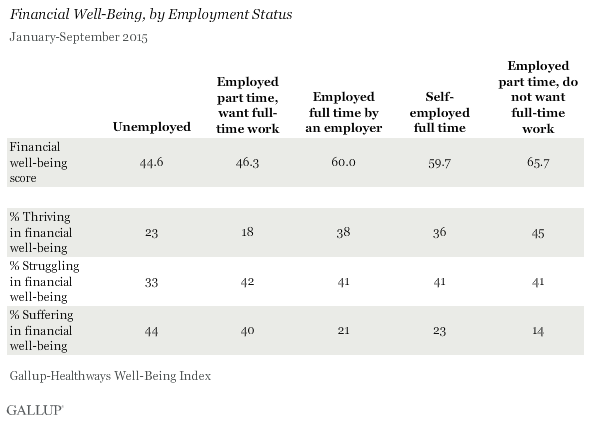
The Organisation for Economic Co-operation and Development (OECD) notes that "involuntary part-time work comprises three groups: 1) individuals who usually work full time but who are working part time because of economic slack, 2) individuals who usually work part time but are working fewer hours in their part-time jobs because of economic slack and 3) those working part time because full-time work could not be found." Someone working as little as a few hours a week would be considered "employed" by the U.S. federal government, which is striking because their financial well-being is similar to a person who does not have a job.
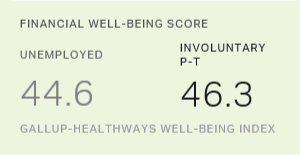
These numbers are based on data collected daily from January through September 2015 as part of the Gallup-Healthways Well-Being Index. To assess financial well-being, Gallup and Healthways ask U.S. adults about their ability to afford food and healthcare, whether they have enough money to do everything they want to do, whether they worried about money in the past week and their perceptions of their standard of living compared with those they spend time with. Financial well-being is calculated on a scale of zero to 100, where zero represents the worst possible financial well-being and 100 represents the best possible financial well-being.
The financial well-being score for the U.S. as a whole was 59.7 in 2014, the first year Gallup and Healthways measured financial well-being using the current questions. The only group whose well-being score greatly exceeds that is part-time workers who do not want full-time work, registering at 65.7.
Food and Healthcare Insecurity High for Involuntary Part-Time Workers
Consistent with their lower financial well-being, those who work part time but are looking for full-time work are nearly as likely as the unemployed -- about three in 10 in each group -- to report having lacked enough money for food or healthcare/medicine at least once in the prior 12 months. In contrast, only about 12% of their full-time employed counterparts report similar challenges. Part-time workers who do not want full-time work report the lowest levels of insecurity of all major employment groups, reflecting the typically enhanced socio-economic status of these households.
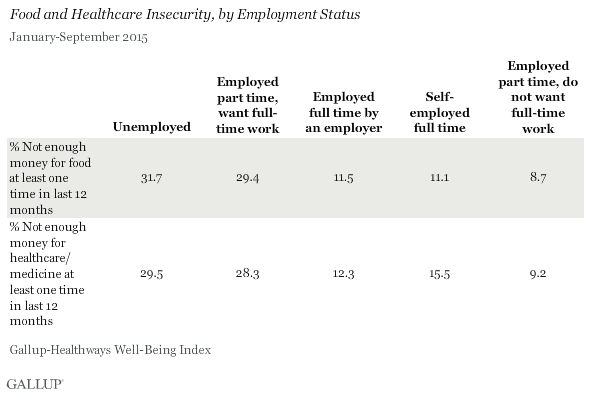
Involuntary part-time workers and the unemployed also report similar levels of agreement about having "enough money to do everything I want to do." In addition, about half in each group report worrying about money in the last seven days, compared with about one-third of full-time workers.
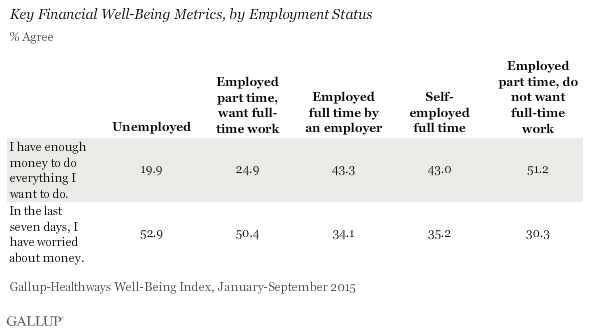
Involuntary Part-Time Workers Slightly Lower in 2015
While involuntary part-time workers experience financial hardships that are very similar to the unemployed, the percentage of part-time workers who want full-time work has shown little decline over the last five years. Since 2010, the percentage of involuntary part-time workers has typically stayed between 8.6% and 9.9% in seasonally unadjusted estimates through 2014. In 2015, however, the reported percentages measured in each of the first three quarters represent five-year lows in relation to the corresponding quarters preceding them, and the 8% estimate for the most recent quarter is the lowest since measurement began.
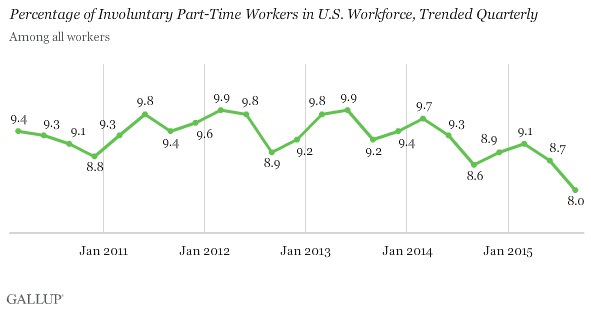
Implications
As the U.S. economy attempts to recover from the Great Recession, part-time workers who want full-time work endure as a detriment to the progress of financial well-being nationally. These adults are essentially no better off in their overall financial well-being than are the unemployed and, in fact, are less likely to be thriving in their financial well-being.
Since the onset of daily measurement in 2010 -- the first calendar year after the official end of the Great Recession -- the percentage of U.S. workers who were involuntarily working part-time jobs has only recently shown signs of decline.
This decline may signify that Americans are feeling a modest amount of financial relief. Gallup's underemployment rate, which is a combination of the unemployment rate and the involuntary part-time rate, was 14.1% in September, its lowest since daily tracking began in 2010. And, given the close relationship between unemployment, involuntary part-time employment and food insecurity, it is likely that the decline in the underemployment rate has played a role in the reduction of food insecurity to its seven-year low, reported earlier this year.


